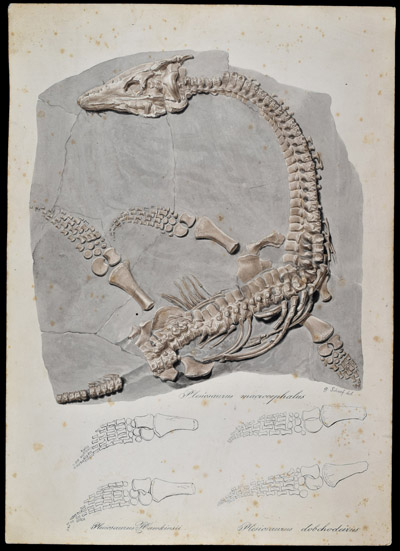A 'lady like' find, 1830-1831

|
| Watercolour of the teeth of the fossil fish Acrodus anningiae Agassiz by Joseph Dinkel, [1834], from the collection of William Willoughby Cole, later 3rd Earl of Enniskillen. Archive ref: LDGSL/616/2/77/13. The species, found in the Lias, Lyme Regis, was named by Louis Agassiz in honour of Mary Anning - possibly indicating that the specimen was found by her. |
In December 1830, Mary Anning discovered another first - a juvenile form of a new species of plesiosaur. It was almost perfect save for one of the back paddles and some of the tail but its compact form, being around half the size of other plesiosaur specimens, made it very attractive to potential buyers. As William Buckland wrote to Roderick Murchison the following month:
"...do you hear of any purchasers of Mary Anning's new little specimen of that kind it is such a Lady like little thing that I wonder you can resist making a present of it to Mrs Murchison." Extract from a letter from William Buckland to Roderick Murchison, 31 January 1831. Archive ref: LDGSL/838/B/34/2
If Murchison was tempted, he was too late. It had already been snapped up by William Willoughby Cole (1807-1886, GSL membership no.716), later the 3rd Earl of Enniskillen, for the massive sum of 200 guineas. Lord Cole and his great friend Sir Philip de Malpas Egerton (1806-1881, GSL membership no.753) were both fossil collectors, travelling the British Isles in search of specimens, including in the company of Mary Anning.

|
Watercolour of the Plesiosaurus macrocephalus, by George Scharf, [1838]. Archive ref: LDGSL/108.
|
An image of the new plesiosaur was included in William Buckland’s book 'Geology and mineralogy considered with reference to natural theology' (1836), where it was briefly compared with two nearly complete examples of Plesiosaurus dolichodeirus both of which had been discovered by Anning. Buckland found that although it was a much younger and smaller specimen, many of its bones were thicker and stouter than these plesiosaurs. The larger nature of its head led Buckland to name it - Plesiosaurus macrocephalus.
The watercolour on the right, by the natural history illustrator George Scharf (1788-1860), was commissioned to accompany a paper by Richard Owen "A description of Viscount Cole's specimen of a Plesiosaurus macrocephalus" [Transactions of the Geological Society of London, S2-5 (1838)] which was read before the Society on 4 April 1838. Owen’s paper offered a more detailed anatomical description of the little plesiosaur but compared it with another species this time from Thomas Hawkins’ collection – named Plesiosarus Hawkinsii.
Unlike Buckland’s description, Mary Anning’s name appears nowhere in the paper, only its owner is referenced. The specimen, along with the rest of Lord Cole’s palaeontological collection, is now housed at the Natural History Museum.
<<Back to main page
Next: Sea Dragons>>